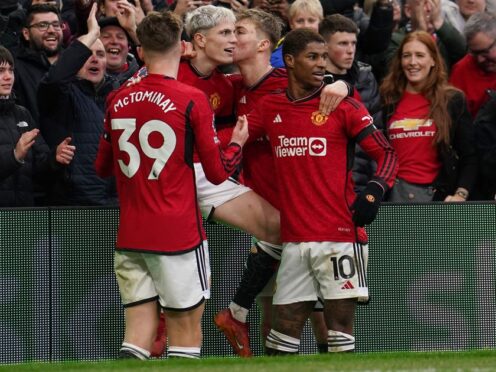
Manchester United relied most on homegrown players in this season’s Premier League and their academy also produced the most players for the top flight as a whole.
In a difficult season for Erik ten Hag’s side, their renowned youth policy remains a source of optimism and here, the PA news agency looks at the player development statistics.
United out in front
🥶#MUFC pic.twitter.com/P8iGJ3VDA1
— Manchester United (@ManUtd) May 16, 2024
PA has matched each player in this season’s top flight to the academy where he finished his youth career and the data shows 21 United academy graduates made appearances.
Ten of those played for United themselves, led by Alejandro Garnacho. The Argentina winger, who joined United’s academy as a 16-year-old from Atletico Madrid, played 2,805 league minutes including stoppage time, with seven goals and four assists.
Marcus Rashford, Scott McTominay and emerging star Kobbie Mainoo also cleared 2,000 minutes while 1,500-plus for Jonny Evans, who made his debut in 2007 in a previous spell at United, provided a link to the club’s long-term reputation for youth development.
Their matchday squad has featured at least one academy graduate in a mind-blowing 4,259 consecutive first-team games dating back to October 1937.
League-wide, James Garner’s 3,372 minutes for Everton were the most of any United graduate, while Andreas Pereira, Teden Mengi, Anthony Elanga, Tahith Chong and Sam Johnstone also topped 2,000.
United’s total of 34,076 minutes was 7,000 clear of last season’s leading academy Chelsea, whose graduates this time racked up 27,075 minutes. Champions Manchester City were third on 20,684.
Ten Hag gave more than a quarter of United’s playing time to players developed in-house, 11,835 minutes out of a total of 42,297 (28 per cent). No other club cleared 20 per cent, with Chelsea second on 8,213 minutes – 19 per cent of their total of 42,562.
Leading academies

The Premier League’s biggest clubs are well represented in the study with the top three trailed by Liverpool in fourth (17,329 minutes) and Arsenal in sixth, sandwiching Nottingham Forest.
Relegated Sheffield United ranked seventh, just ahead of the first non-Premier League academies, Flamengo and Barcelona. The Blades’ Vinicius Souza (3,002 minutes) and Joao Gomes of Wolves (2,930) were the leading products of the Brazilian club, with Barca’s 10,578 minutes led by 3,850 for ever-present Manchester United goalkeeper Andre Onana.
Everton complete the top 10, with Paris St Germain the 11th and final academy to crack 10,000 minutes.
Charlton were the leading EFL club in 16th having produced defenders Ezri Konsa, Alfie Doughty and Joe Gomez – regulars for Aston Villa, Luton and Liverpool respectively.
A total of 273 academies were represented with 178 providing just a solitary player each, Celta Vigo bringing up the rear with 11 minutes for Jonny before his departure from Wolves.
Homegrown hopes

Chelsea used 10 of their own academy players, matching United, and were represented by a league-high 24 total graduates – although Jimi Tauriainen played only two minutes and he, Mason Burstow and Josh Acheampong totalled barely half an hour.
Liverpool ranked third for homegrown playing time with Jarell Quansah, Conor Bradley, Bobby Clark and Jayden Danns among those to break through in a total of 7,069 minutes – almost 17 per cent of the Reds’ playing time.
Newcastle and Crystal Palace completed the top five, but almost as notable is the other end of the homegrown table, where for the second consecutive season Brentford did not use a single graduate of their own academy. Everton got 11 combined minutes from Tom Cannon, Lewis Warrington and Tyler Onyango, while Luke Harris made a single appearance for Fulham.
Eighty-seven players made Premier League appearances for the club who developed them, ranging from Tyrick Mitchell’s 3,551 minutes for Crystal Palace to Tauriainen and Onyango’s two minutes each.

Enjoy the convenience of having The Sunday Post delivered as a digital ePaper straight to your smartphone, tablet or computer.
Subscribe for only £5.49 a month and enjoy all the benefits of the printed paper as a digital replica.
Subscribe